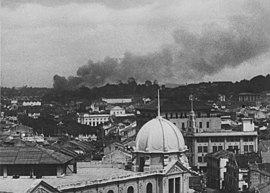Kabu Civil War
This article is incomplete because it is pending further input from participants, or it is a work-in-progress by one author. Please comment on this article's talk page to share your input, comments and questions. Note: To contribute to this article, you may need to seek help from the author(s) of this page. |
| Kabu Civil War | |||||||
|---|---|---|---|---|---|---|---|
Clockwise from top left: Smoke rises over Kutha Pamungkas in 1941; Kabu Republic soldiers inspecting captured councilist equipment; Kabuese delegates at the Treaty of CITY; Sutikno Harjo declares the Socialist Republic of Kabu in 1941. | |||||||
| |||||||
| Belligerents | |||||||
|
Supported by: |
Supported by: | ||||||
| Commanders and leaders | |||||||
|
|
| ||||||
| Strength | |||||||
|
|
| ||||||
| Casualties and losses | |||||||
|
|
| ||||||
The Kabu Civil War (Kabuese: Perang Sipil Kabupik) was a civil war fought on the Kabu Archipelago between the anti-communist Kabu Republic and the BKMI-led Socialist Republic of Kabu. The war began on 25 January 1941 and lasted until the signing of the Treaty of NON CRINGE CITY on March 14 1947. The war was considered a proxy war between the Socialist world and the various blocs emerging to oppose the expansion of socialism, with major supporters of each side including Soravia and Estmere for the North and Kirenia for the south.
While united in their demands for self governance for the Kabuese archipelago tensions emerged between the followers of Purnama Sutoro and the BKMI as the formers nationalist philosophy clashed with the internationalist council socialist policy of the latter organisation. These tensions became apparent after the end of the Gaullican occupation of the archipelago in 1935 as the BKMI wished to align the anti-colonial movement with Kirenia a move which saw strong opposition from the followers of Sutoro. As agitation against Estmere made self governance an increasingly likely scenario the uneasy alliance between the two movements started to break down further as large disagreements on internal policy emerged. After a failed attempt at self governance in 1940 disagreements between the BKMI and Sutoro's followers became more apparent, ultimately leading to both factions establishing paramilitaries which would become embroiled in violence against one another. In early 1941 the attempt at self governance was abandoned as both parties officially took up arms against each other, with the official starting point of the war being Sutoro's declaration of his intent to "eradicate socialism on the archipelago."
(Course of the war)
Towards the end of 1945 active combat in the war had declined as both sides had consolidated control over their respective halves of the archipelago, with the BKMI controlling the South-west and the Kabu Republic controlling the North-east and fighting remained limited to mostly naval battles between the two. While the conflict officially remained active throughout 1946 both sides eventually came to the conclusion that consolidating control over their half of the archipelago was more important than continuing the conflict thus both parties entered negotiations which resulted in the Treaty of CITY which would establish the states of North Kabu and South Kabu in the territories which were controlled by both sides respectively. However relations remained sour between both sides with each side continuing to claim to be the legitimate government of all of Kabu.
Background
Aftermath of the Great War
- Gaullican occupation of the Kabu Archipelago
- Demands for Home rule & Estmerish promises of home rule if the islands were liberated
- Promises fail to materialise. Anti-Estmerish groups such as Purnama's Patangists and the BKMI grow in popularity and form an uneasy alliance against Estmerish rule
- Guerrilla campaigns and mass protests in favour of anti-Estmere groups
- Attempt at home rule for Kabu in wake of pressure
- 19XX Legislative assembly election held. Patangist and BKMI joint list wins a large majority. Moderate groups fail to gain traction
Split between Purnama and Sutikno
- Tensions begin to emerge over views on international relations. BKMI wishes for backing from Kirenian groups which is opposed by Purnama
- In light of this, economic disagreements become more apparent. Patangists oppose BKMI attempts to collectivise agriculture
- Attempts at diplomatic relations with Kirenia crushed by Patangists opposition
- BKMI withdraws from power sharing agreements.
Breakdown of self-governance
- New legislative elections in August 1940. Campaign marked by violence by paramilitaries associated with BKMI and Patangists. Result unclear and neither group wins a majority. Rural voters support BKMI and Patangists win urban voters.
- Initial attempts at forming a government fail. Paramilitary violence continues
- Patangists attempt to form a government with moderates. BKMI refuses to show up for votes. Legislative assembly does not reach quorum, BKMI consider new government as illegitimate
- BKMI form separate government and declare the Kabu Socialist Republic
- Purnama Sutoro as Premier of Kabu promises to deal with "Socialist insurgency"



